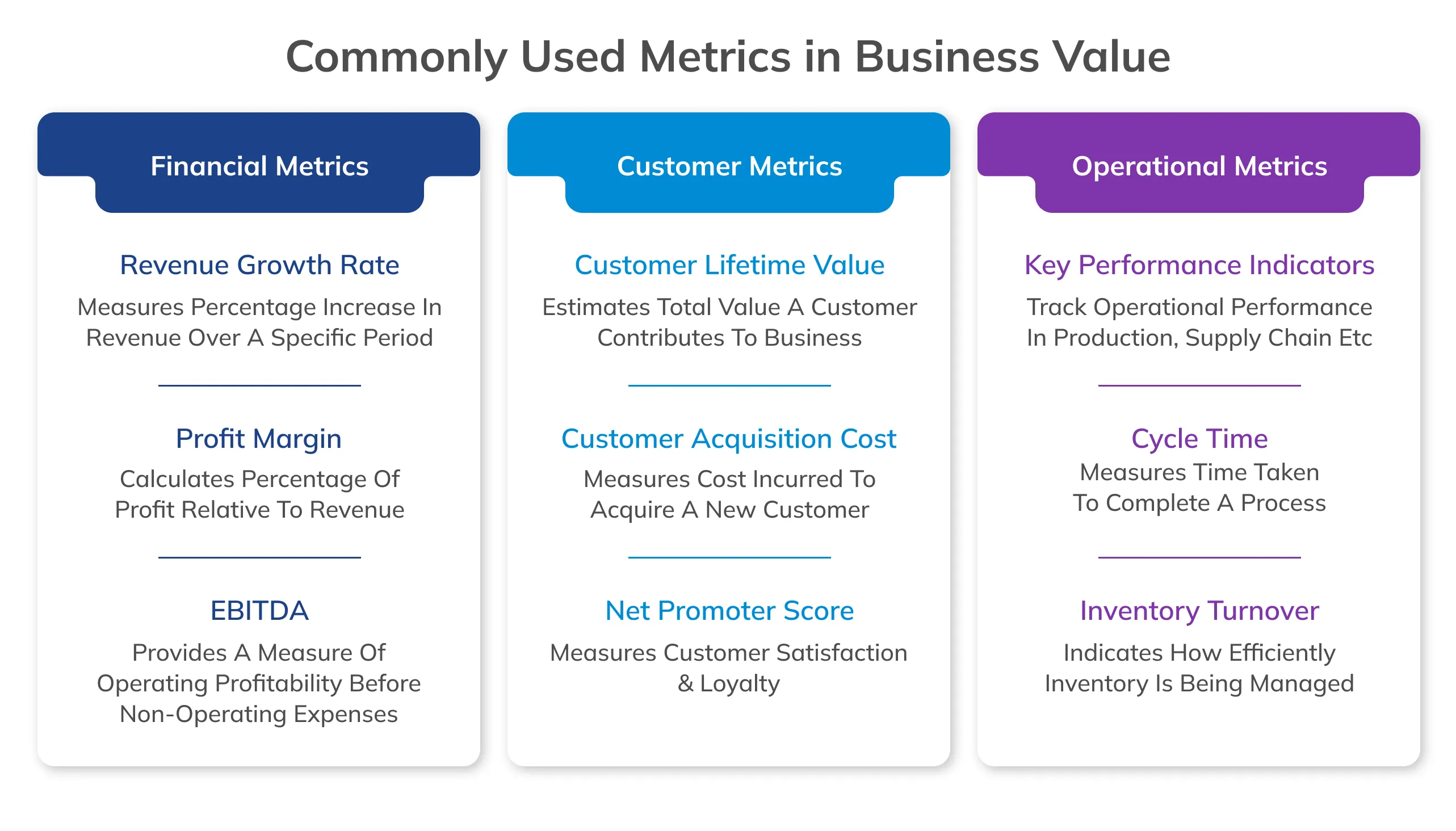
Business value refers to the worth of an organization for its stakeholders substantiated through its operations, products, and services. The value is determined on the basis of financial metrics like revenue and profit and intangible assets including brand reputation and customer loyalty. Business value reflects a company's ability to deliver sustainable returns and achieve its strategic objectives in both the short and long term. For this reason, increasing business value is crucial for businesses' long-term success and sustainability.
Effective value creation helps businesses foster growth opportunities, strengthen stakeholder relationships, and build resilience against economic uncertainties. However, till date, companies struggle to increase business value because of multiple factors like inadequate strategic planning and execution, inefficient financial management, operational inefficiencies, etc.
This blog highlights the top six strategies to boost business value.
Here’s a look at the six key strategies that companies can implement to enhance their financial attractiveness, operational efficiency, and overall market appeal. By adopting these strategies, businesses can position themselves for sustainable growth, successful exits, or increased investment opportunities.
Understanding and delivering on customers' needs and preferences has a direct impact on an enterprise’s business value. should strive to generate an attractive value proposition that aligns with their target audience. This involves offering high-quality products or services, exceptional customer experiences, and superior value relative to competitors. By prioritizing customer satisfaction and loyalty, businesses can reduce customer churn and enhance brand reputation, ultimately increasing business value.
Innovation is a key driver of business value. It lets enterprises stay ahead of the competition and meet evolving market demands. Enterprises should foster a culture of innovation and experimentation, encouraging employees to generate new ideas and solutions. This could involve developing products, processes, technologies, or business models to create unique value propositions. By continuously innovating and differentiating themselves in the marketplace, businesses can capture market share, attract customers, and command premium pricing, thereby increasing business value. According to a report by McKinsey, companies with strong innovative cultures are more likely to succeed in digital transformation.
A skilled and motivated workforce is a valuable asset that contributes significantly to business value. Businesses should invest in recruiting, training, and retaining top talent, aligning employee skills with organizational goals. This involves providing competitive compensation packages, opportunities for career advancement, and ensuring a supportive work environment. By developing a high-performing team, businesses can drive innovation, improve customer satisfaction, and achieve operational excellence, thereby increasing business value.

Diversifying market reach and revenue streams is essential for reducing dependency on specific markets or customer segments. Businesses should explore opportunities to expand geographically, enter new markets, or target additional customer segments. This could involve strategic partnerships, mergers and acquisitions, or launching new product lines. By diversifying their revenue streams, businesses can overcome risks including market volatility, competitive pressure, cyclical trends, capitalize on growth opportunities, and increase overall business value.
Building a strong brand and reputation is critical for increasing business value and fostering customer trust and loyalty. Businesses should invest in brand-building activities through marketing, advertising, and public relations. This involves consistently delivering on brand promises, engaging with customers through various channels, and managing brand perception effectively. By enhancing brand equity and reputation, businesses can command premium pricing, attract customers, and differentiate themselves from competitors, ultimately increasing business value.

Effective financial management is essential for maximizing shareholder value and ensuring long-term financial sustainability. Businesses should maintain sound financial practices, including budgeting, forecasting, and cash flow management. This involves monitoring key financial metrics, managing working capital efficiently, and optimizing capital allocation decisions. By maintaining a strong financial discipline, businesses can improve profitability, reduce financial risks, and enhance investor confidence, ultimately increasing business value.
Business value plays a significant role in the success and longevity of organizations across industries. It serves as a guiding metric for stakeholders by providing insight into the health and performance of the organization. investors, business value reflects the attractiveness and growth potential of a company. A high business value signals a promising investment opportunity, while a decline may indicate underlying challenges or risks. Such insights enable investors to pledge their capital in a risk-free and informed way. Therefore, it is essential for businesses to maintain and enhance their value from time to time with effective planning.
However, many businesses deal with negative publicity, product recalls, or ethical lapses that damage their brand reputation, erode customer trust, and undermine business value. Therefore, they can only excel and stay laser-focused on their market reception and growth when they are not bogged down by the burden of executing administrative tasks. However, administrative duties, while essential, can consume valuable time and resources that could otherwise be directed towards strategic initiatives. This is where outsourcing administrative tasks to specialized service providers can make a significant difference.
At Invensis, we offer comprehensive administrative support services, including data entry, document management, customer support, and back-office operations. By entrusting these tasks to us, businesses can free up their internal resources to concentrate on core competencies and market-facing activities. This strategic approach not only optimizes resource allocation but also enables businesses to stay agile, responsive, and competitive in today's dynamic marketplace, ultimately leading to greater success and market reception.
Contact us to drive sustainable growth and maximize your business value with our back office services.
Category

Business profits are essential for sustainability. Explore impactful strategies on how to improve business profitability to enhance financial strength.
May 16, 2024
|

Optimized shipping costs help businesses achieve greater efficiency and resource allocation. Know how to reduce shipping costs here.
May 16, 2024
|

Outsourcing allows businesses to focus on core functions and accelerate growth. Get a comprehensive explanation of outsourcing in this blog.
May 16, 2024
|
